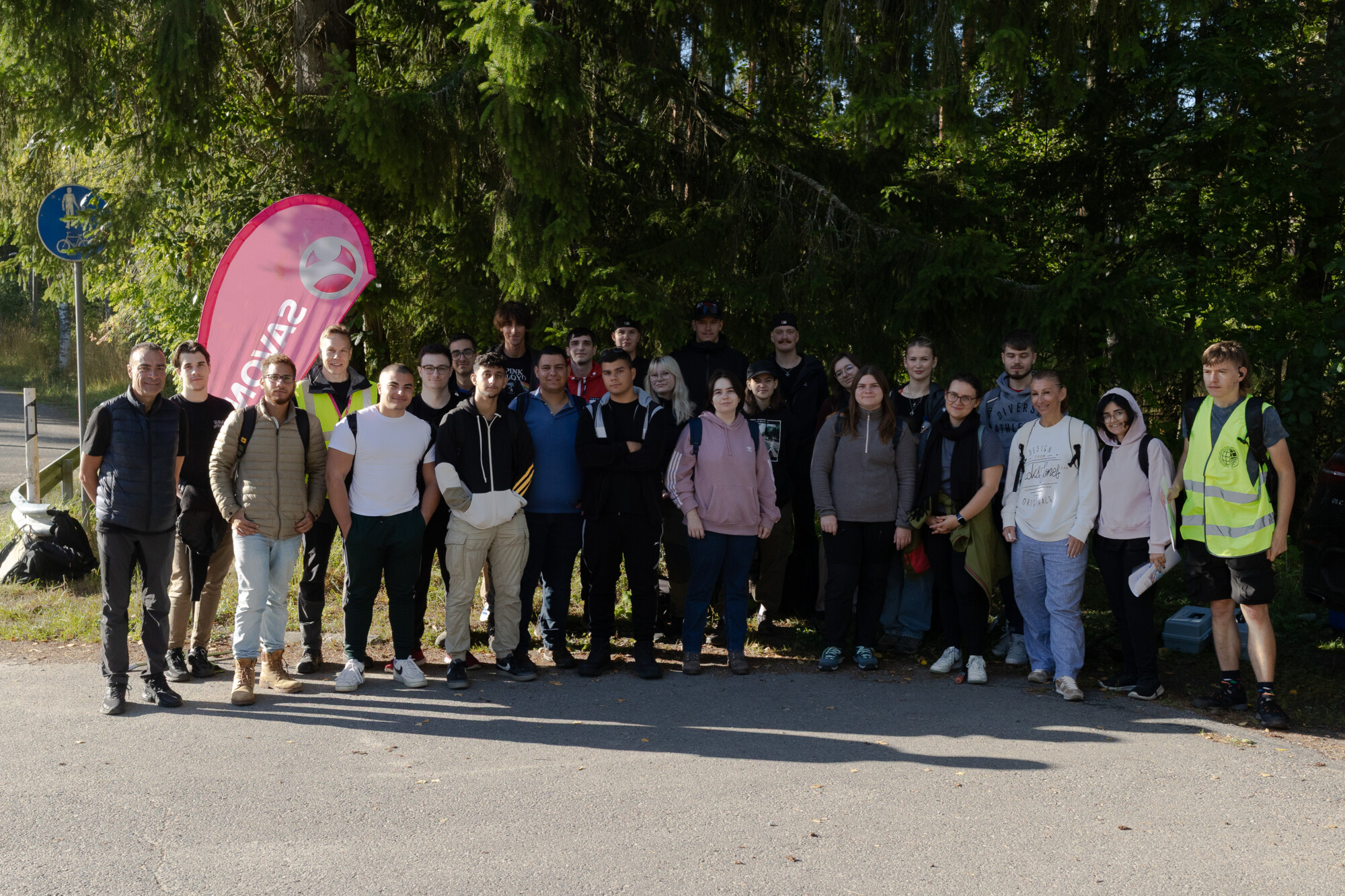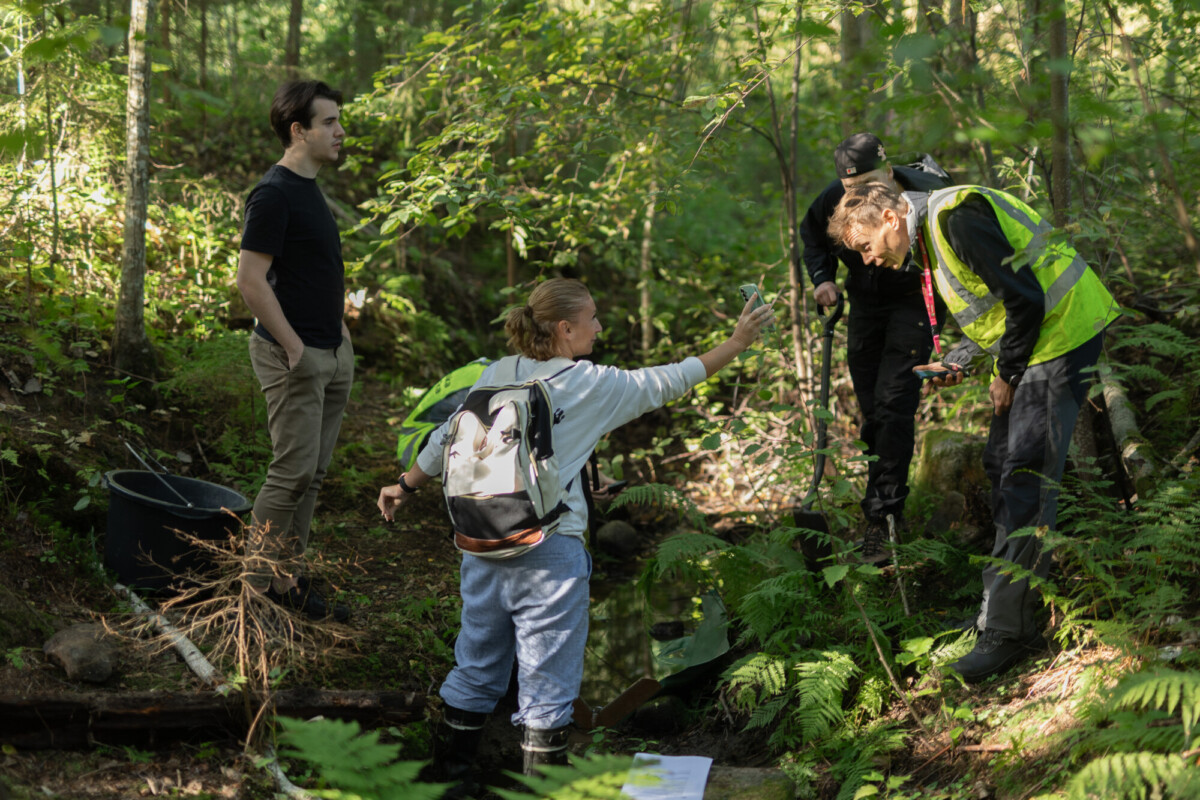
Savonia Article: Learning by Nature: ERASMUS+ BIP in Monitoring Natural Waters
This work is licensed under CC BY-SA 4.0
Hands-on learning meets cross-border collaboration
In September 2025, Savonia University of Applied Sciences hosted a Blended Intensive Programme (BIP) Monitoring Natural Waters, bringing together 25 students from EU4Dual Partners KUT (Poland), MCAST (Malta), and Savonia (Finland), in addition to an exchange student from Spain. Natural waters are a critical natural resource all over the world and working towards cleaner waters is a common goal for all of us. The aim of this blended intensive program was to provide more information on how you can influence the quality of water bodies and have a better understanding of working together towards cleaner natural waters. Over an intensive week in Kuopio, theory met practice: virtual studies, fieldwork at Lake Pieni-Valkeinen, and lab analyses converged to build a deeper understanding of ecology, water quality, and sustainable management.
“The course changed my perspective on the environment around us.”
From virtual classrooms to Finnish lakeshores
Before arriving in Finland, students engaged in virtual modules that laid the groundwork—water ecosystem basics, hydrological theory, and introductions to threats facing natural waters. Once in Kuopio, they stepped into field studies: measuring hydrological parameters, collecting samples, and observing firsthand how local features shape freshwater ecosystems. Laboratory work followed, translating raw data into insights.
The program included collaboration with industry partners. At the start of the intensive week, participants learned about the practical work of the Water Protection Association of Savo-Karjala. We also explored Savonia’s research projects with companies, which have developed innovative methods for catchment-based water protection and the treatment of mining waters.
“I liked that the main focus was not on theory but on practical exercises and using our knowledge.”
“It strengthened my understanding of freshwater ecosystems and inspired me to consider how water monitoring supports sustainable management and protection of these fragile environments.”

These reflections show that learning in nature, under guidance, makes the theoretical real and memorable.
Cultural exchange amplifies learning
One distinguishing feature of the BIP was international teamwork. Students worked in mixed-nationality groups, sharing perspectives and probing each other’s assumptions. Working together in the field and lab revealed not only ecological subtleties, but also cultural ones: different ways of approaching scientific work, communication styles, and ways of thinking.
“The groups were an amazing way to interact with students from other countries.”
Such intercultural interactions enhanced both the learning and the sense of shared responsibility for global environmental issues.
Feedback: What moved students—and what they wished
A survey conducted after the program reflected strong student satisfaction: nearly all students rated the course as excellent and expressed that they would recommend it to others. What they especially appreciated was the:
- Practical work: field measurements and lab work over pure lectures
- Balance between indoor and outdoor study
- Collaborative atmosphere and the chance to broaden their horizons educationally and interculturally
On the improvement side, many expressed their wish for a longer duration—to allow more time for reflection and deeper analysis of data.
Teacher insights: Challenges met, lessons learned
Organizing this first edition of the BIP involved careful planning. Coordinating virtual preparatory work across countries, arranging lab access and field logistics, and ensuring safety. All were demanding tasks, yet, what stood out was how flexible students and teachers proved to be.
The experience showed that having a systematic approach is essential for success. Virtual learning environments and their assignments must be clear and well-structured. The activities during the intensive week need to be planned in advance, and student groups should be given sufficiently clear instructions on what to do next. This is especially important on a course such as this, where students come from different academic backgrounds and may not be familiar with water protection practices.
However, the topic of the course was chosen so that, regardless of background, everyone has a clear and shared experience of the subject — water is a vital element for all of us. This made it easier to understand the assignments and provided a shared context for the fieldwork activities.
It was evident that hands-on, place-based learning has strong motivational power. Students who had never done hydrological measurements became deeply engaged. The generative mix of field, lab, and international peers is a formula worth retaining and refining.

Looking ahead: stronger, longer, deeper
Based on feedback, future editions might consider:
- Extending the program’s duration
- Additional follow-up virtual sessions to deepen the connections made and the material learned
The potential of digital learning environments to automate feedback on assignments should also be more widely utilized. The direction is clearly moving toward a model where the learning tasks completed before and after the intensive week would resemble fully MOOC-style studies. MOOC (Massive Open Online Course) refers to an open-access online course designed for large-scale participation, often allowing students to study independently, at their own pace, and with automated feedback systems.
It must be said, however, that the greatest value of this intensive course lies in the genuine human encounters and the hands-on activities in an authentic learning environment — in this case, at Lake Pieni-Valkeinen and in the water laboratory. The virtual learning tasks served only as an introduction to the topic and as a summarising element of the overall experience.
Shared responsibility, lasting impact
The Monitoring Natural Waters BIP was more than an academic course—it was an experience of shared discovery and responsibility. Students left with not only technical knowledge and field skills, but also with a belief that they can make a difference in protecting natural waters. Such programs align with Savonia’s mission: to educate experts who are not only skilled, but also aware, collaborative, and ready to meet global challenges.
Meeting people from different cultures is always an opportunity to learn. As a teacher, I learned a lot about water quality and water availability across different parts of Europe. This significantly broadened my perspective by providing a regional view on these issues.
The impacts of climate change are significantly more severe in Mediterranean countries such as Malta and Spain. These effects became tangible through discussions and students’ assignment responses. The catchment areas of Finland and Poland both drain into the shared Baltic Sea, which made it particularly interesting to discuss the common environmental challenges and responsibilities we face.
Clean water is essential for life, ecosystems, and communities. While governments and industries play a major role in water management, every individual can make a difference through everyday choices, environmental care, and active participation. There are many practical ways, like buying locally produced food and avoiding unnecessary water use, that citizens can do to help protect water quality and ensure the availability of clean freshwater — both directly and indirectly. Moreover, teaching children about the importance of clean water and raising awareness about water issues builds long-term responsibility. In this way, each of us can contribute to building a sustainable future and protecting natural waters.
Organizing this Blended Intensive Program was a truly rewarding experience, and we hope to have the opportunity to implement it again in collaboration with our EU4DuaL partners. The challenges related to the quality of natural waters require attention, and we are committed to being part of the effort to address them.
Authors:
Teemu Räsänen, Senior Lecturer, Environmental Engineering, Savonia University of Applied Sciences
Zainab Elgundi, International Relations Planner, Savonia University of Applied Sciences